engine oil YAMAHA XL 700 2001 Owners Manual
[x] Cancel search | Manufacturer: YAMAHA, Model Year: 2001, Model line: XL 700, Model: YAMAHA XL 700 2001Pages: 111, PDF Size: 12.05 MB
Page 25 of 111
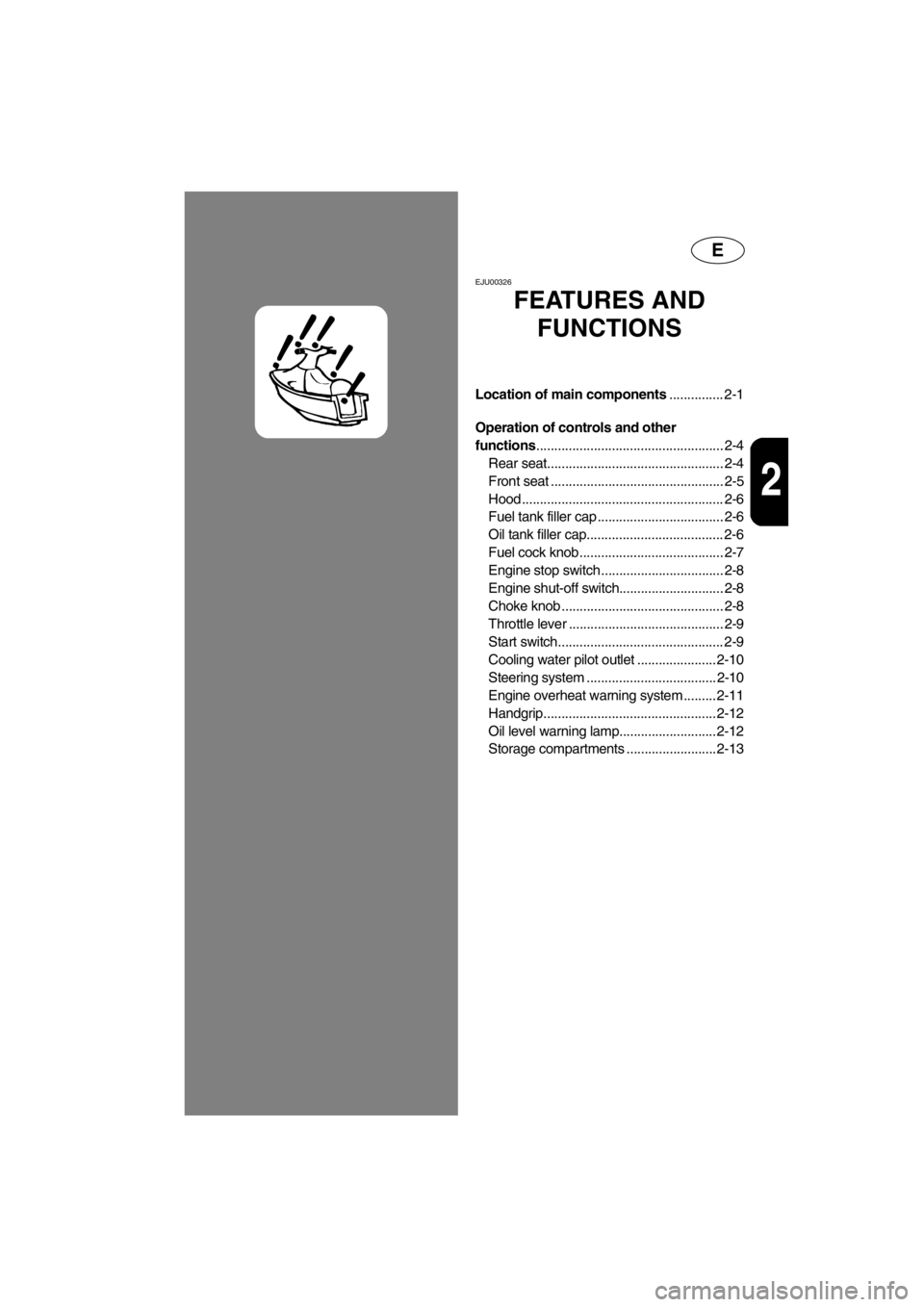
E
2
EJU00326
FEATURES AND
FUNCTIONS
Location of main components............... 2-1
Operation of controls and other
functions.................................................... 2-4
Rear seat................................................. 2-4
Front seat ................................................ 2-5
Hood ........................................................ 2-6
Fuel tank filler cap ................................... 2-6
Oil tank filler cap...................................... 2-6
Fuel cock knob........................................ 2-7
Engine stop switch .................................. 2-8
Engine shut-off switch............................. 2-8
Choke knob ............................................. 2-8
Throttle lever ........................................... 2-9
Start switch.............................................. 2-9
Cooling water pilot outlet ...................... 2-10
Steering system .................................... 2-10
Engine overheat warning system ......... 2-11
Handgrip................................................ 2-12
Oil level warning lamp........................... 2-12
Storage compartments ......................... 2-13
E_F0M-72-2TOC.fm Page 1 Thursday, July 27, 2000 9:50 AM
Page 26 of 111
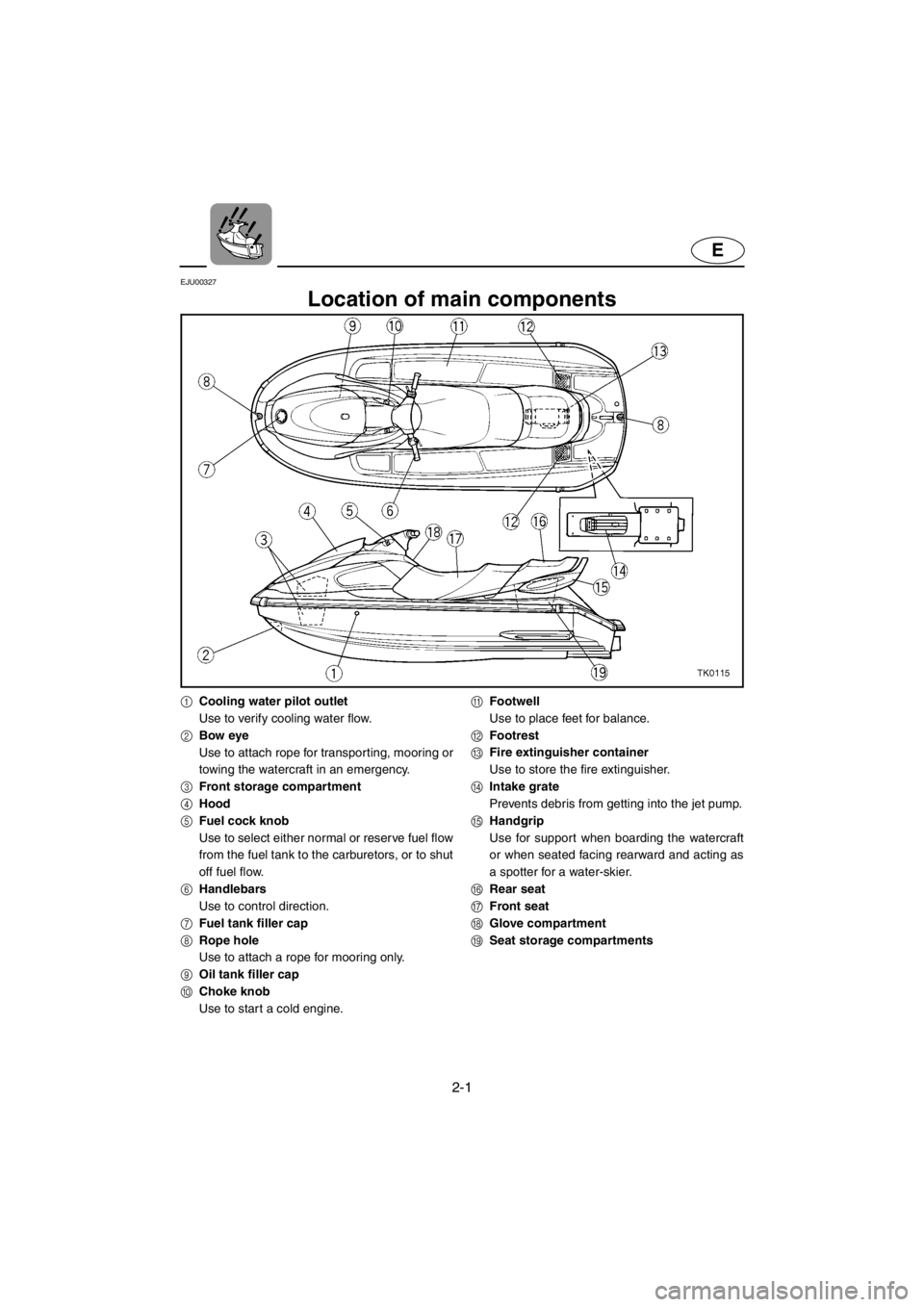
2-1
E
EJU00327
Location of main components
1Cooling water pilot outlet
Use to verify cooling water flow.
2Bow eye
Use to attach rope for transporting, mooring or
towing the watercraft in an emergency.
3Front storage compartment
4Hood
5Fuel cock knob
Use to select either normal or reserve fuel flow
from the fuel tank to the carburetors, or to shut
off fuel flow.
6Handlebars
Use to control direction.
7Fuel tank filler cap
8Rope hole
Use to attach a rope for mooring only.
9Oil tank filler cap
0Choke knob
Use to start a cold engine.AFootwell
Use to place feet for balance.
BFootrest
CFire extinguisher container
Use to store the fire extinguisher.
DIntake grate
Prevents debris from getting into the jet pump.
EHandgrip
Use for suppor t when boarding the watercraft
or when seated facing rearward and acting as
a spotter for a water-skier.
FRear seat
GFront seat
HGlove compartment
ISeat storage compartments
E_F0M-72-2.fm Page 1 Thursday, July 27, 2000 9:50 AM
Page 27 of 111
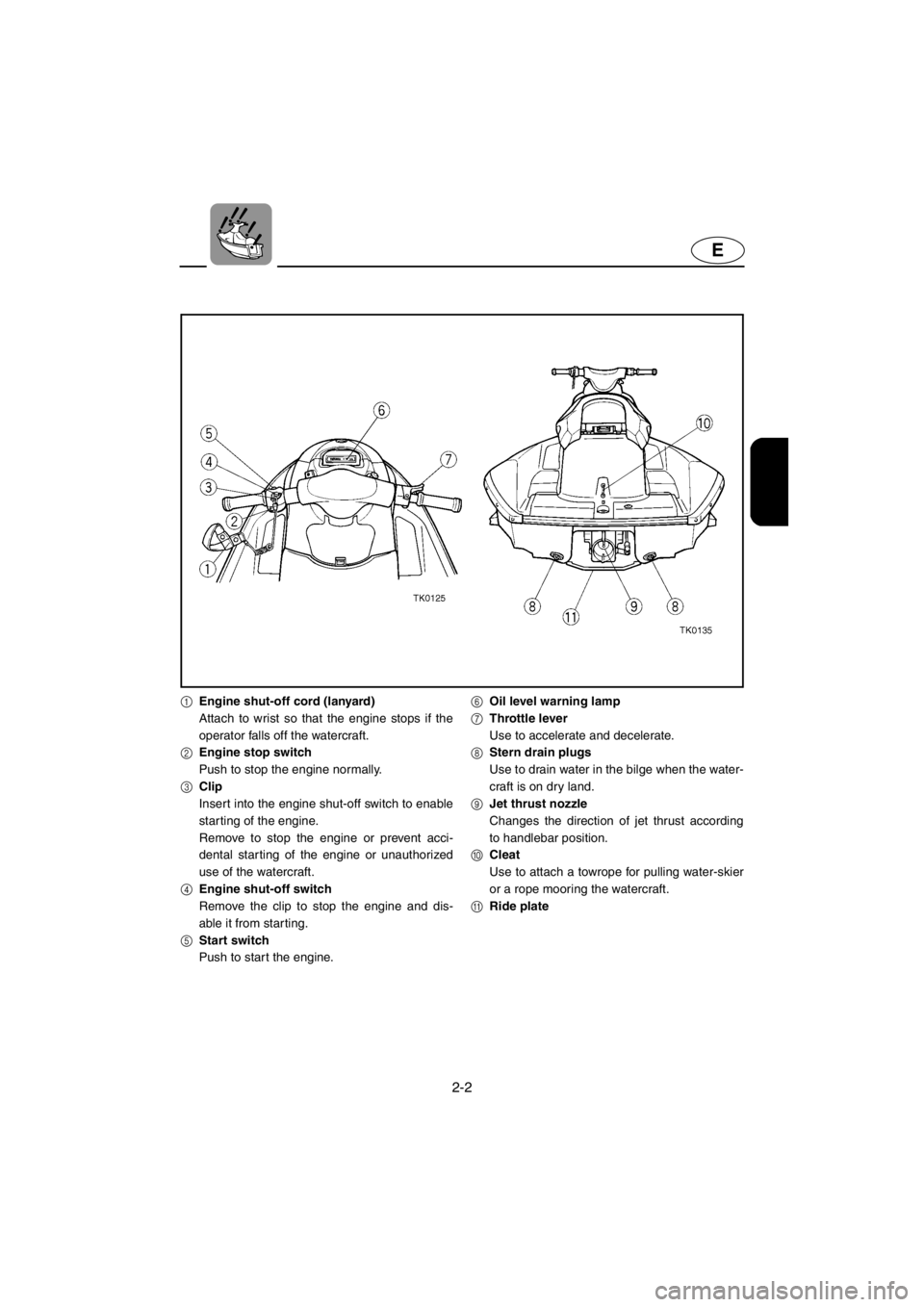
2-2
E
1Engine shut-off cord (lanyard)
Attach to wrist so that the engine stops if the
operator falls off the watercraft.
2Engine stop switch
Push to stop the engine normally.
3Clip
Insert into the engine shut-off switch to enable
starting of the engine.
Remove to stop the engine or prevent acci-
dental star ting of the engine or unauthorized
use of the watercraft.
4Engine shut-off switch
Remove the clip to stop the engine and dis-
able it from starting.
5Start switch
Push to start the engine.6Oil level warning lamp
7Throttle lever
Use to accelerate and decelerate.
8Stern drain plugs
Use to drain water in the bilge when the water-
craft is on dry land.
9Jet thrust nozzle
Changes the direction of jet thrust according
to handlebar position.
0Cleat
Use to attach a towrope for pulling water-skier
or a rope mooring the watercraft.
ARide plate
E_F0M-72-2.fm Page 2 Thursday, July 27, 2000 9:50 AM
Page 28 of 111
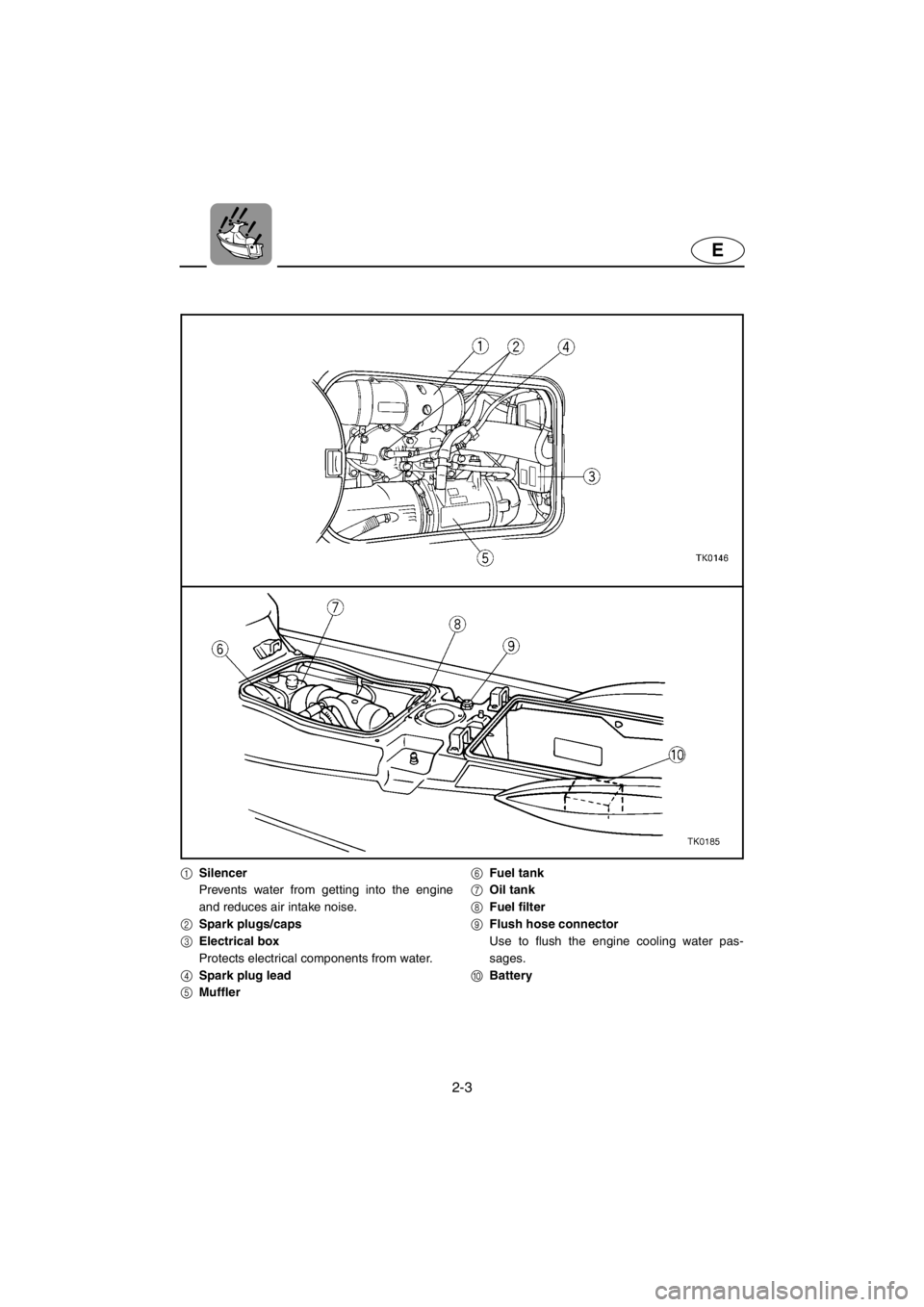
2-3
E
1Silencer
Prevents water from getting into the engine
and reduces air intake noise.
2Spark plugs/caps
3Electrical box
Protects electrical components from water.
4Spark plug lead
5Muffler6Fuel tank
7Oil tank
8Fuel filter
9Flush hose connector
Use to flush the engine cooling water pas-
sages.
0Battery
E_F0M-72-2.fm Page 3 Thursday, July 27, 2000 9:50 AM
Page 37 of 111
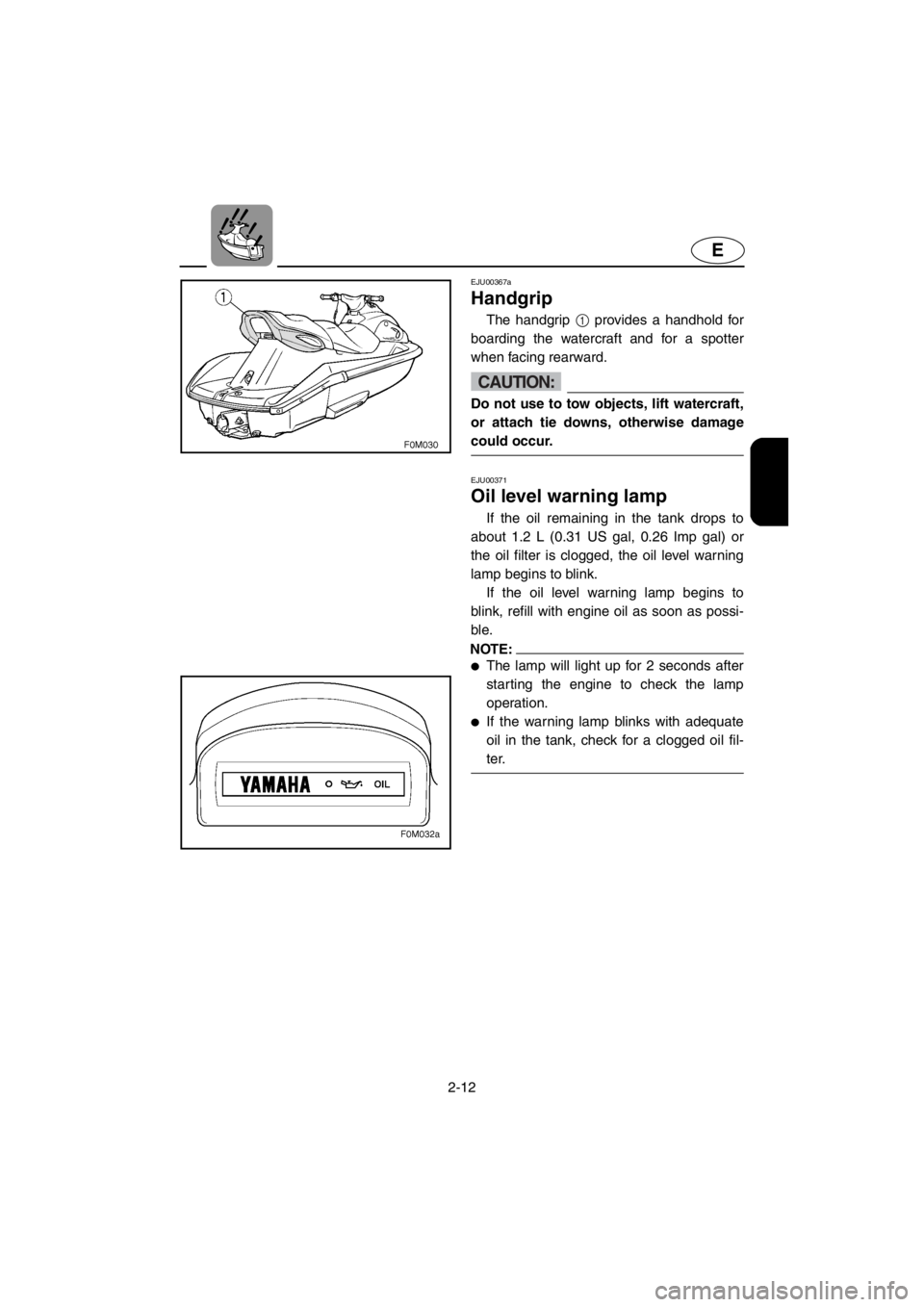
2-12
E
EJU00367a
Handgrip
The handgrip 1 provides a handhold for
boarding the watercraft and for a spotter
when facing rearward.
CAUTION:
Do not use to tow objects, lift watercraft,
or attach tie downs, otherwise damage
could occur.
EJU00371
Oil level warning lamp
If the oil remaining in the tank drops to
about 1.2 L (0.31 US gal, 0.26 Imp gal) or
the oil filter is clogged, the oil level warning
lamp begins to blink.
If the oil level warning lamp begins to
blink, refill with engine oil as soon as possi-
ble.
NOTE:
●The lamp will light up for 2 seconds after
starting the engine to check the lamp
operation.
●If the warning lamp blinks with adequate
oil in the tank, check for a clogged oil fil-
ter.
E_F0M-72-2.fm Page 12 Thursday, July 27, 2000 9:50 AM
Page 41 of 111
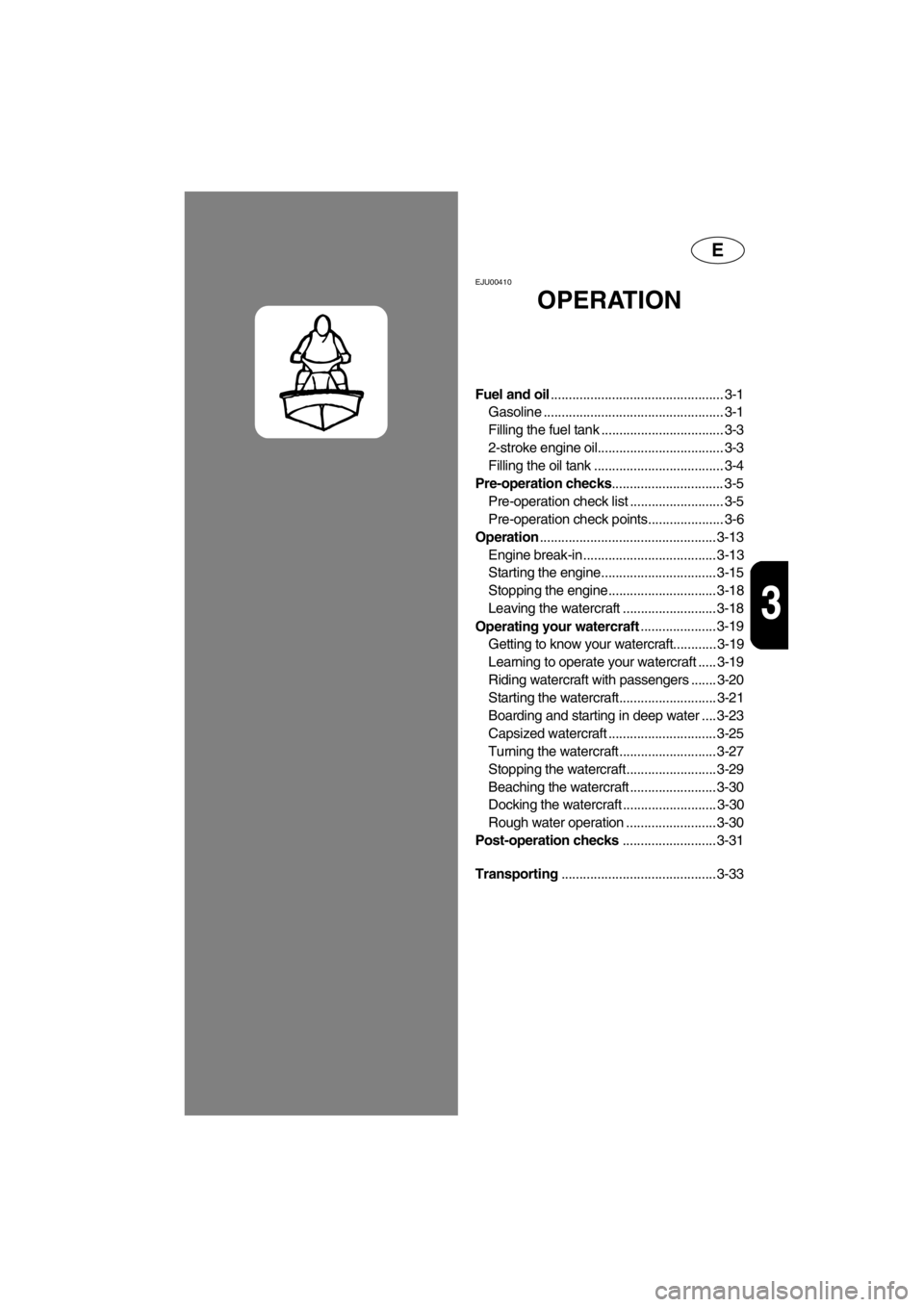
E
3
EJU00410
OPERATION
Fuel and oil................................................ 3-1
Gasoline .................................................. 3-1
Filling the fuel tank .................................. 3-3
2-stroke engine oil................................... 3-3
Filling the oil tank .................................... 3-4
Pre-operation checks............................... 3-5
Pre-operation check list .......................... 3-5
Pre-operation check points..................... 3-6
Operation................................................. 3-13
Engine break-in ..................................... 3-13
Starting the engine................................ 3-15
Stopping the engine.............................. 3-18
Leaving the watercraft .......................... 3-18
Operating your watercraft..................... 3-19
Getting to know your watercraft............ 3-19
Learning to operate your watercraft ..... 3-19
Riding watercraft with passengers ....... 3-20
Starting the watercraft........................... 3-21
Boarding and starting in deep water .... 3-23
Capsized watercraft .............................. 3-25
Turning the watercraft........................... 3-27
Stopping the watercraft......................... 3-29
Beaching the watercraft ........................ 3-30
Docking the watercraft .......................... 3-30
Rough water operation ......................... 3-30
Post-operation checks.......................... 3-31
Transporting........................................... 3-33
E_F0M-72-3TOC.fm Page 1 Thursday, July 27, 2000 9:51 AM
Page 42 of 111
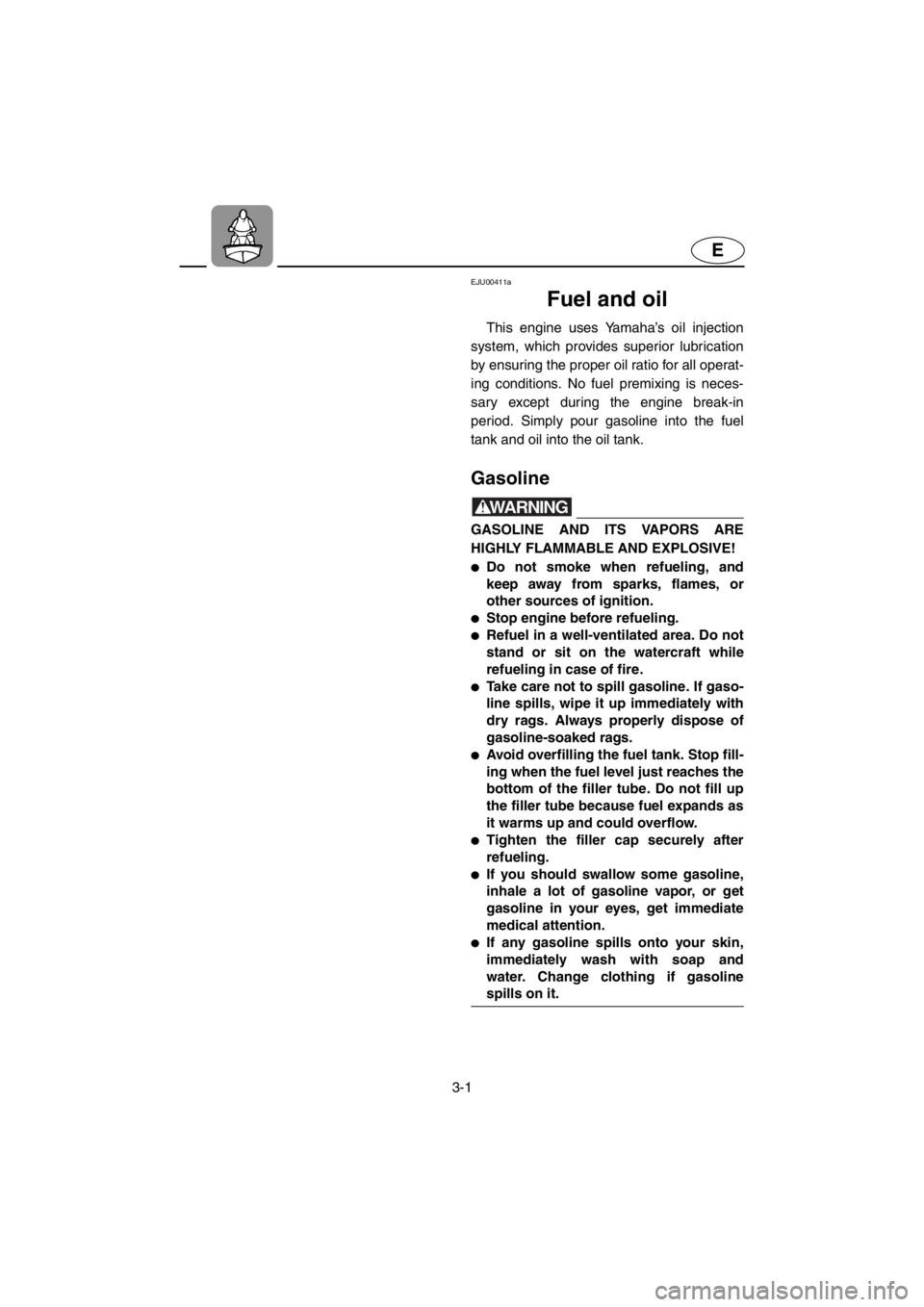
3-1
E
EJU00411a
Fuel and oil
This engine uses Yamaha’s oil injection
system, which provides superior lubrication
by ensuring the proper oil ratio for all operat-
ing conditions. No fuel premixing is neces-
sary except during the engine break-in
period. Simply pour gasoline into the fuel
tank and oil into the oil tank.
Gasoline
WARNING
GASOLINE AND ITS VAPORS ARE
HIGHLY FLAMMABLE AND EXPLOSIVE!
●Do not smoke when refueling, and
keep away from sparks, flames, or
other sources of ignition.
●Stop engine before refueling.
●Refuel in a well-ventilated area. Do not
stand or sit on the watercraft while
refueling in case of fire.
●Take care not to spill gasoline. If gaso-
line spills, wipe it up immediately with
dry rags. Always properly dispose of
gasoline-soaked rags.
●Avoid overfilling the fuel tank. Stop fill-
ing when the fuel level just reaches the
bottom of the filler tube. Do not fill up
the filler tube because fuel expands as
it warms up and could overflow.
●Tighten the filler cap securely after
refueling.
●If you should swallow some gasoline,
inhale a lot of gasoline vapor, or get
gasoline in your eyes, get immediate
medical attention.
●If any gasoline spills onto your skin,
immediately wash with soap and
water. Change clothing if gasoline
spills on it.
E_F0M-72-3.fm Page 1 Thursday, July 27, 2000 9:52 AM
Page 44 of 111
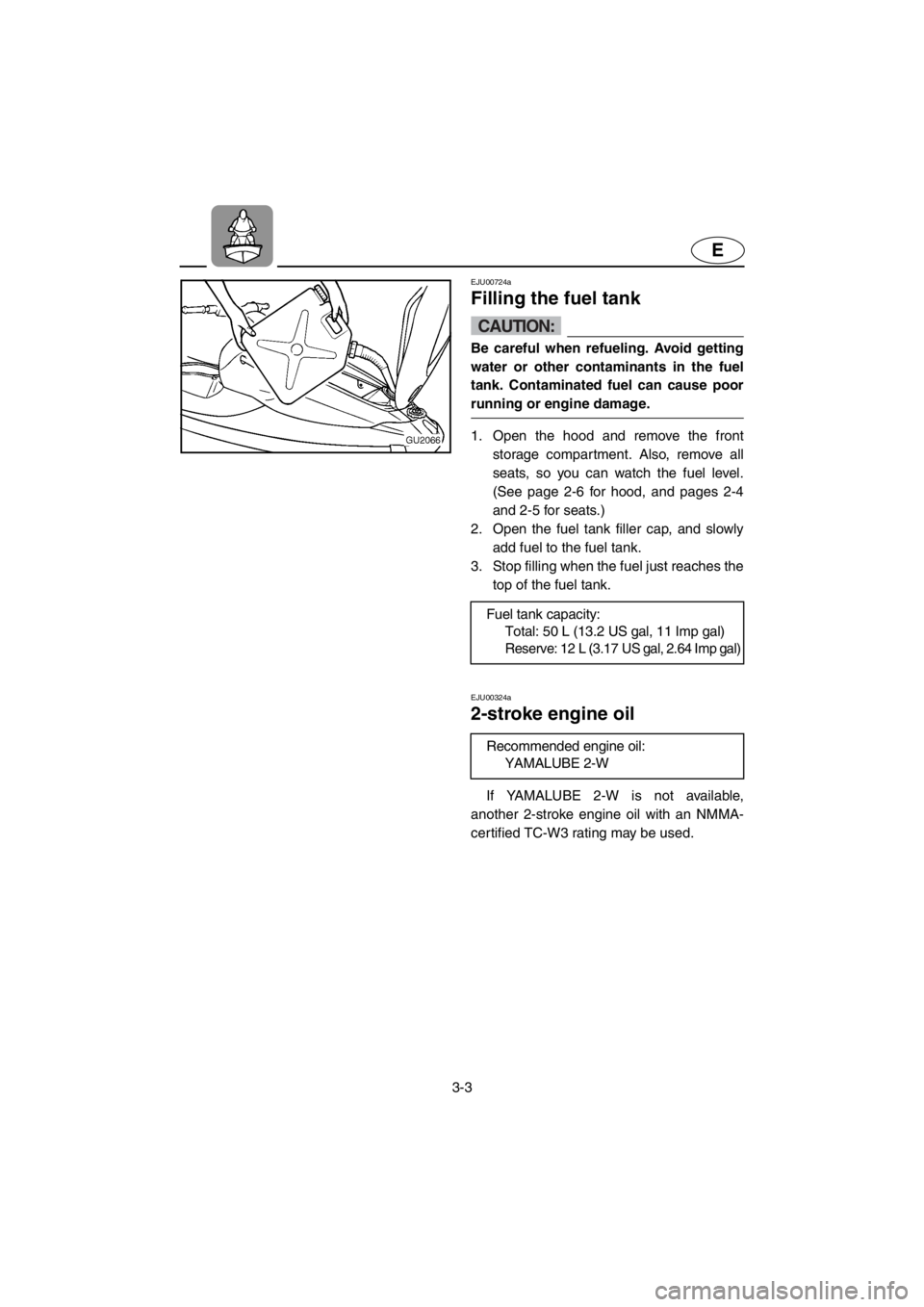
3-3
E
EJU00724a
Filling the fuel tank
CAUTION:
Be careful when refueling. Avoid getting
water or other contaminants in the fuel
tank. Contaminated fuel can cause poor
running or engine damage.
1. Open the hood and remove the front
storage compartment. Also, remove all
seats, so you can watch the fuel level.
(See page 2-6 for hood, and pages 2-4
and 2-5 for seats.)
2. Open the fuel tank filler cap, and slowly
add fuel to the fuel tank.
3. Stop filling when the fuel just reaches the
top of the fuel tank.
EJU00324a
2-stroke engine oil
If YAMALUBE 2-W is not available,
another 2-stroke engine oil with an NMMA-
certified TC-W3 rating may be used.Fuel tank capacity:
Total: 50 L (13.2 US gal, 11 Imp gal)
Reserve: 12 L (3.17 US gal, 2.64 Imp gal)
Recommended engine oil:
YAMALUBE 2-W
E_F0M-72-3.fm Page 3 Thursday, July 27, 2000 9:52 AM
Page 45 of 111
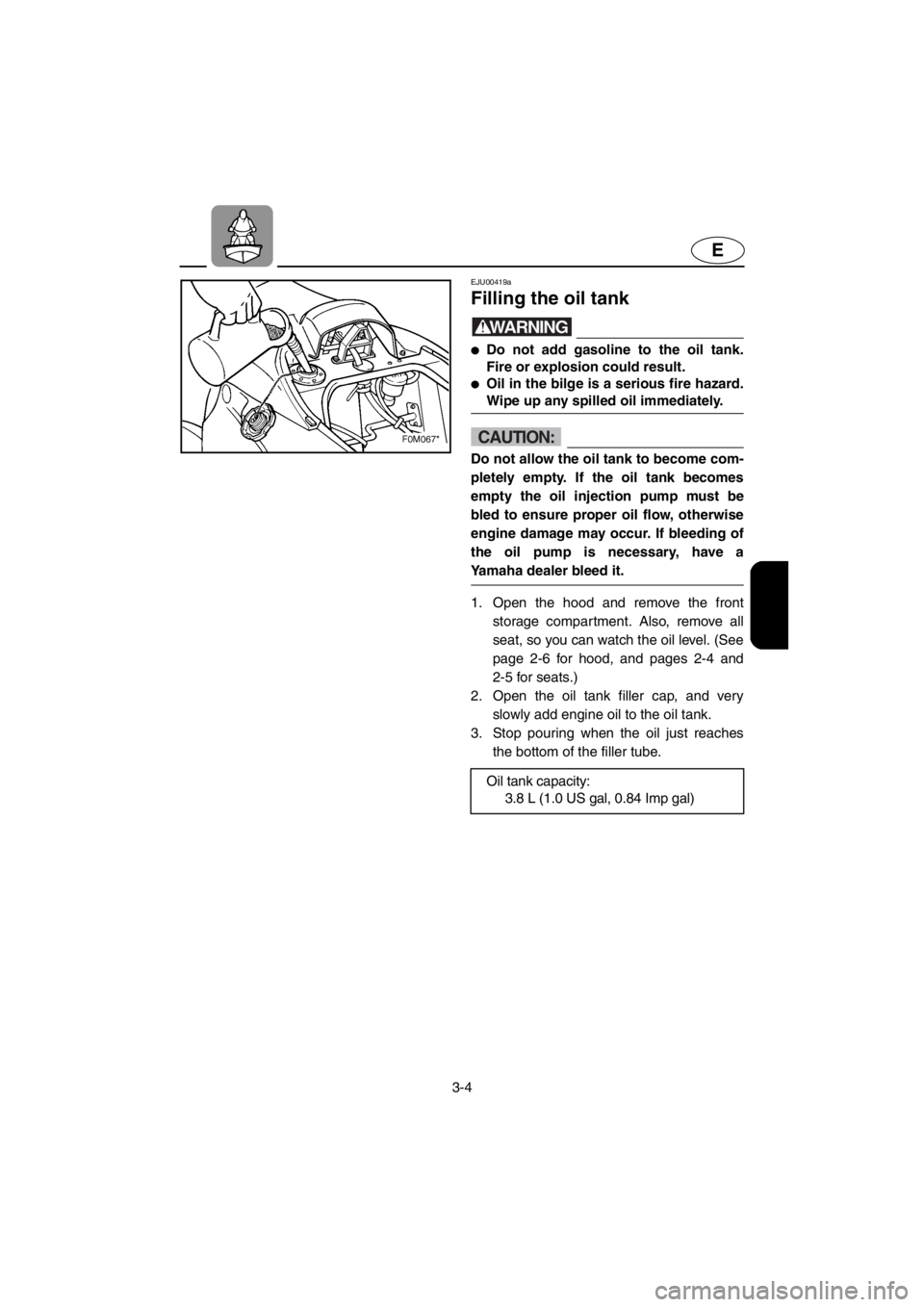
3-4
E
EJU00419a
Filling the oil tank
WARNING
●Do not add gasoline to the oil tank.
Fire or explosion could result.
●Oil in the bilge is a serious fire hazard.
Wipe up any spilled oil immediately.
CAUTION:
Do not allow the oil tank to become com-
pletely empty. If the oil tank becomes
empty the oil injection pump must be
bled to ensure proper oil flow, otherwise
engine damage may occur. If bleeding of
the oil pump is necessary, have a
Yamaha dealer bleed it.
1. Open the hood and remove the front
storage compartment. Also, remove all
seat, so you can watch the oil level. (See
page 2-6 for hood, and pages 2-4 and
2-5 for seats.)
2. Open the oil tank filler cap, and very
slowly add engine oil to the oil tank.
3. Stop pouring when the oil just reaches
the bottom of the filler tube.
Oil tank capacity:
3.8 L (1.0 US gal, 0.84 Imp gal)
E_F0M-72-3.fm Page 4 Thursday, July 27, 2000 9:52 AM
Page 46 of 111
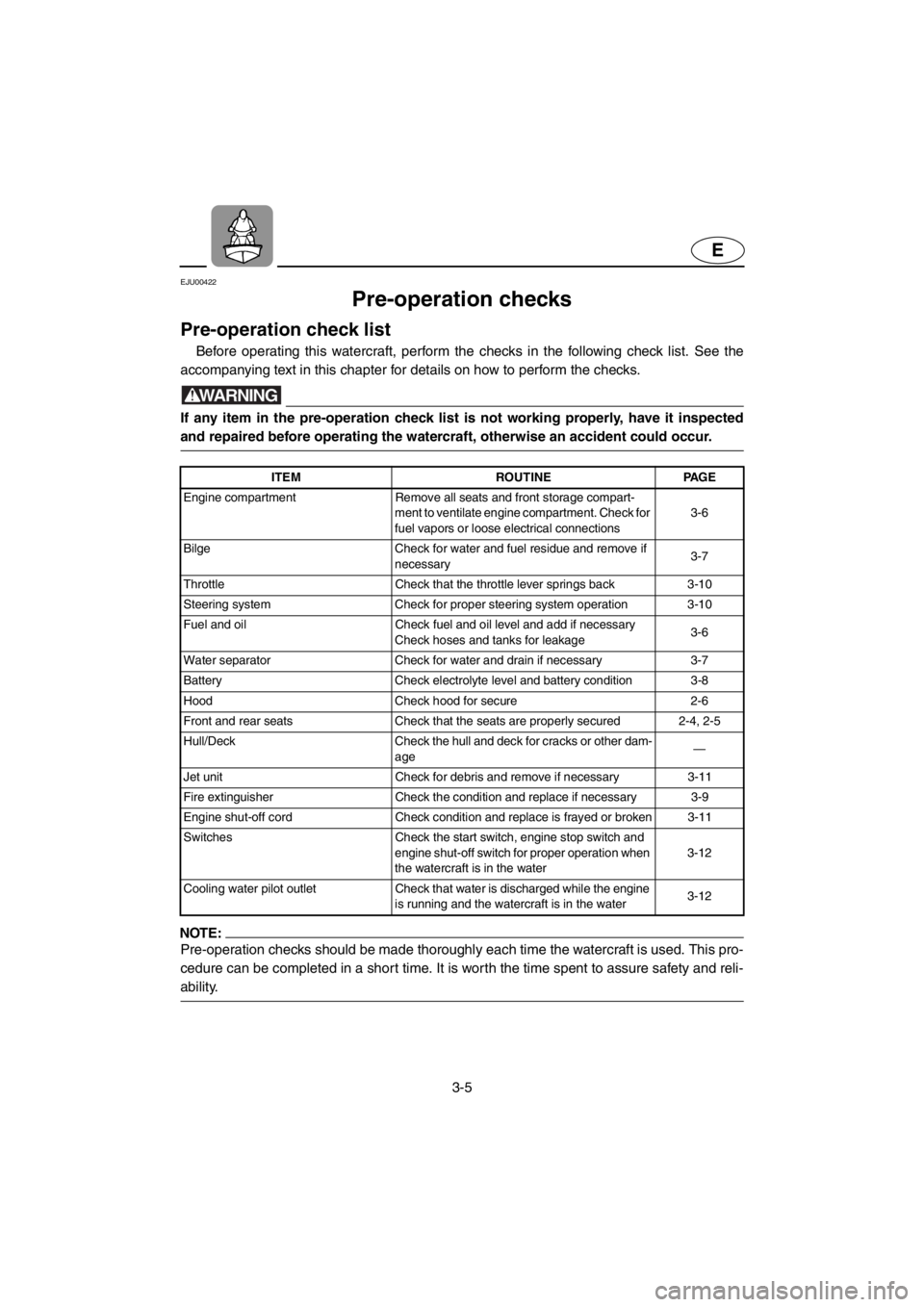
3-5
E
EJU00422
Pre-operation checks
Pre-operation check list
Before operating this watercraft, perform the checks in the following check list. See the
accompanying text in this chapter for details on how to perform the checks.
WARNING
If any item in the pre-operation check list is not working properly, have it inspected
and repaired before operating the watercraft, otherwise an accident could occur.
NOTE:
Pre-operation checks should be made thoroughly each time the watercraft is used. This pro-
cedure can be completed in a short time. It is worth the time spent to assure safety and reli-
ability.
ITEM ROUTINE PAGE
Engine compartment Remove all seats and front storage compart-
ment to ventilate engine compartment. Check for
fuel vapors or loose electrical connections3-6
Bilge Check for water and fuel residue and remove if
necessary3-7
Throttle Check that the throttle lever springs back 3-10
Steering system Check for proper steering system operation 3-10
Fuel and oil Check fuel and oil level and add if necessary
Check hoses and tanks for leakage3-6
Water separator Check for water and drain if necessary 3-7
Battery Check electrolyte level and battery condition 3-8
Hood Check hood for secure 2-6
Front and rear seats Check that the seats are properly secured 2-4, 2-5
Hull/Deck Check the hull and deck for cracks or other dam-
age—
Jet unit Check for debris and remove if necessary 3-11
Fire extinguisher Check the condition and replace if necessary 3-9
Engine shut-off cord Check condition and replace is frayed or broken 3-11
Switches Check the start switch, engine stop switch and
engine shut-off switch for proper operation when
the watercraft is in the water3-12
Cooling water pilot outlet Check that water is discharged while the engine
is running and the watercraft is in the water3-12
E_F0M-72-3.fm Page 5 Thursday, July 27, 2000 9:52 AM